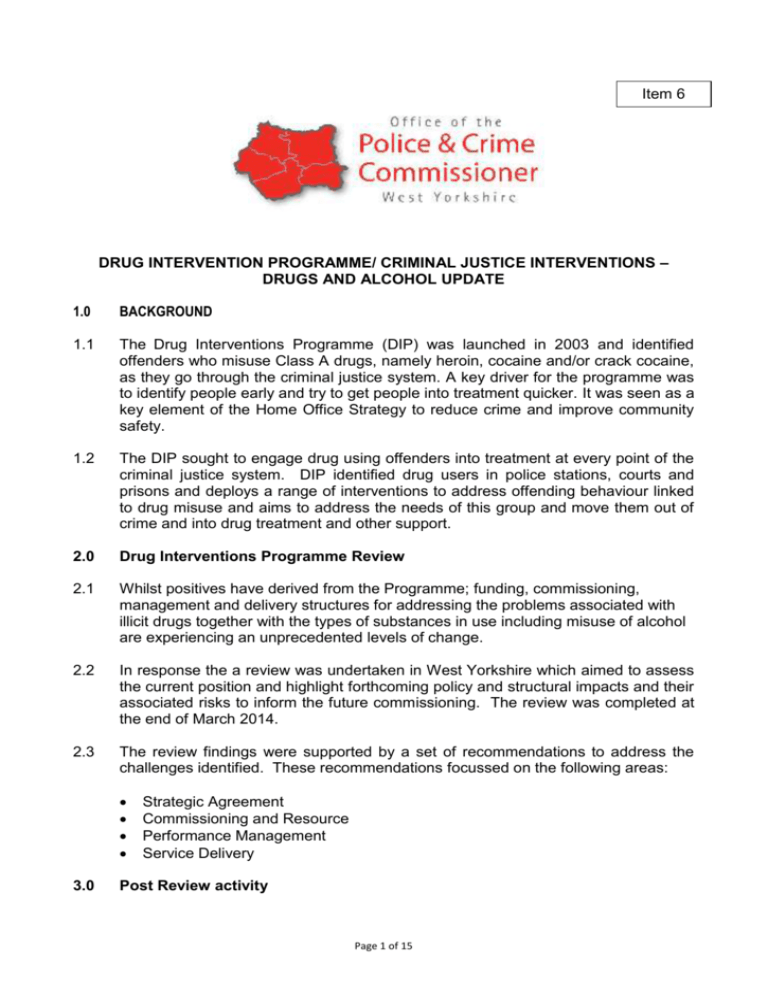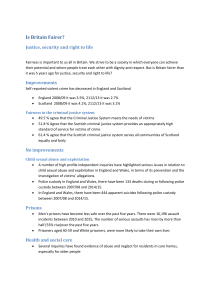Item 6 - Drug Intervention Programme Funding
advertisement

Item 6 DRUG INTERVENTION PROGRAMME/ CRIMINAL JUSTICE INTERVENTIONS – DRUGS AND ALCOHOL UPDATE 1.0 BACKGROUND 1.1 The Drug Interventions Programme (DIP) was launched in 2003 and identified offenders who misuse Class A drugs, namely heroin, cocaine and/or crack cocaine, as they go through the criminal justice system. A key driver for the programme was to identify people early and try to get people into treatment quicker. It was seen as a key element of the Home Office Strategy to reduce crime and improve community safety. 1.2 The DIP sought to engage drug using offenders into treatment at every point of the criminal justice system. DIP identified drug users in police stations, courts and prisons and deploys a range of interventions to address offending behaviour linked to drug misuse and aims to address the needs of this group and move them out of crime and into drug treatment and other support. 2.0 Drug Interventions Programme Review 2.1 Whilst positives have derived from the Programme; funding, commissioning, management and delivery structures for addressing the problems associated with illicit drugs together with the types of substances in use including misuse of alcohol are experiencing an unprecedented levels of change. 2.2 In response the a review was undertaken in West Yorkshire which aimed to assess the current position and highlight forthcoming policy and structural impacts and their associated risks to inform the future commissioning. The review was completed at the end of March 2014. 2.3 The review findings were supported by a set of recommendations to address the challenges identified. These recommendations focussed on the following areas: 3.0 Strategic Agreement Commissioning and Resource Performance Management Service Delivery Post Review activity Page 1 of 15 3.1 In June 2014 the findings and recommendations were presented to key stakeholders (commissioners, partners and providers) with the opportunity to work through the recommendations. The outcome of this session was a series of first outline action plans to take forward the recommendations. 3.2 At the meeting of the Police and Crime Panel in September 2014 I explained that the next stage was to develop a county-wide plan based on the recommendations from the Review report. 3.3 Further work was undertaken by my officers and Nicola Hughes Consulting towards the end of 2014 to which resulted a partnership delivery plan. This plan was subsequently shared with each of the five Community Safety Partnerships and the Force. Responsibility for completing progress against the actions identified sits with our delivery partners and the OPCC. 4.0 Progress 4.1 Since the development of the Delivery Plan four key area of progress to note are: I have had two joint meetings with of Directors of Public Health during which time I highlighted findings of the review Performance improvement indicators have been set in conjunction with Community Safety Partnerships which reflect the need to include alcohol within the remit I have extended funding to the end of March 2016 and contract letters have been sent to the five Leaders of the district’s local authorities Agreed with the wider definition to include criminal justice interventions around drugs and alcohol with clear links to reducing re-offending. DIP will no longer be used as the term to describe either the funding stream or subsequent delivery. 4.2 The first full quarterly returns against this delivery plan should be received from partners by the end of April 2015. 4.3 For this meeting I am able to provide the Panel with a copy of the agreed Delivery Plan which has been updated with information to date. This is shown in the table below. Page 2 of 15 Recommendation R1 future focus of the PCC drugs and alcohol resource should be to formally move away from the name DIP which denotes an isolated project towards supporting ‘criminal justice interventions’ to reduce offending associated with drug and alcohol use Action to progress Language should include: Criminal justice interventions to reduce reoffending, recovery from addiction, restore community confidence, reform from criminality Embed change of language: Contract between PCC and Districts to reflect change of language Performance management framework to reflect change of language Local strategies – Health and Wellbeing Strategy, Crime and Disorder Reduction Strategies Raise at meeting with DPHs need to embed CJ interventions to reduce re-offending associated with drug and alcohol use. R2 A wider definition of the remit of the criminal justice Draft wider definition for comment – utilise suggestion and intervention should be consider inclusion of: agreed to also include: mental health (particularly liaison and diversion Class A, Alcohol, services) cannabis, violent new psycho active substances or explore and crime and disorder analyse the need to do this With a wider focus Overall need to ensure its flexible and allow on entry points to definition to develop to respond to new challenges identify and engage which impact on vulnerable adults with offenders to include increased Consult on and gain agreement to wider definition: early intervention Agree with key partners via meeting with DPHs, and pre-custody Public Health England, CSPForum work in the community Page 3 of 15 Who ALL OPCC OPCC Districts OPCC OPCC Progress Partners report: The new contract name is Criminal Justice Recovery Interventions and this is the term that is used. We are embedding Criminal Justice within the wider Recovery System. The term DIP is unfortunately embedded in day to day language. It has been easier to change the language within strategies/meetings. We are carrying out a strategic review to maximise resources/outcomes relating to a broader set of priorities. The PCC has met with the DPHs to share the findings of the Review and subsequent Delivery Plan. The focus is on partnership delivery of drugs and alcohol reflecting the contribution provided by partners particularly health and local authorities. Wider definition agreed with partners through DPHs, PEG, CSPs. Recommendation Action to progress R3. Drugs and alcohol Hold meeting with DPH/Chairs of HWB. Agenda to should be reflected as a include: priority within key strategic Findings from review partnership plans such as Definition Health and Wellbeing Plan Terminology and JSNAs. Embedding criminal justice responses to reducing reoffending associated with drugs and alcohol in HWB strategies and JSNAs Opportunities for collaboration and periodic reviews to ensure that maximising opportunities for embedding Seek support in securing and coordinating resource commitment to drugs and alcohol Raise profile and need to embed with Community Safety Managers via CSP Forum Who Progress CSP / OPCC with DPH/PEG Partners provide the following information: Districts Secure commitment from councillors and partners at high level. Raise profile of work and outcomes at PEG Local commissioners to fully brief the most appropriate accountable body R4. Strategic agreement across five districts and key drug and alcohol commissioners should be sought on: The definition of the remit of criminal justice interventions (R2) Including criminal justice interventions as part of See above. Strategic agreement to be gained via: DPH/Public Health PEG CSP Forum Drugs/Alcohol District Commissioners Police – Custody and testing OPCC to lead District Commissioners to fully brief internally to the most appropriate accountable body e.g. HW Board, CSP Districts Page 4 of 15 The OPCC has shared the findings of the review throughout its partnership structures including the WY CSP Forum Head of Commissioning for Public Health is a member of the CSP Board and Drugs and Alcohol is embedded within the JSNA. Services will actively contribute to the long term Corporate Strategy by helping people with drug and alcohol misuse problems seek support to treatment and recovery services and to reduce the rates of re-offending. This will also contribute to the Joint Health and Wellbeing Strategy outcome of helping to live longer and have healthier lives. See R2 above Recommendation Action to progress the integrated drug and District Commissioners to guide on which body will be best alcohol commissioning placed for the PCC to influence of services Should form part of the strategic priority and element of DIP/drug criminal justice commissioning Agreement across commissioners to maintaining resource commitment to drug and alcohol services (R7) Who Progress R5. Strategic agreement to new pathways and their interface with criminal justice drug and alcohol services should be gained. Support should be given to providers to establish how ‘new’ delivery will integrate especially at cell intervention level. Opportunities should be explored for achieving greater value for money through re-design and skilling to ensure holistic assessment and pathways to people with multiple and complex needs. OPCC 5 Commissi oners WYP NHSE PHE A six monthly review meeting will be organised during late spring / early summer. The timing will be one year on from the first workshop, and six months following the development of the delivery plan. OPCC will lead to involve each district commissioner and force. Provide opportunity for sharing of approaches and good practice and opportunities for collaboration and piloting across five Local Authority areas. Facilitate six monthly meetings of district commissioners including police representation Conditional Cautioning pilot commenced aimed at changing adult offender behaviour. A working group has been set up with police and key partners to enable more effective engagement and signposting to drug and alcohol services. The pilot will be monitored and include case studies and information around re-offending. Page 5 of 15 Page 6 of 15 Commissioning and Resource Development Recommendation R6. There should be continued investment in criminal justice interventions in drugs and alcohol services with the aim of reducing reoffending of drug and alcohol misusing offenders. The following attached to the funding: • • • • • R7. Clarity on definition of DIP/CJ element Focus on reducing reoffending and indices to support - focus on offence type Action required to progress A new contract should be developed for reducing reoffending of drug and alcohol misusing offenders funding should be developed. The contract issued to district commissioners should contain: Who? OPCC Extension letters of the Community Safety Fund to March 2016 referred to partners being mindful of the findings of the DIP Review. Definition of CJ element Key terminology/requirements of delivery (entry points, crime and offence type focus, etc.) Minimum standards for commissioning (r11) Management and governance arrangements Common performance indicators across 5 districts A common performance management template has been agreed with CSPs and now being used to report back on the Community Safety Fund including that for drugs and alcohol. We are awaiting a proposed indicator regarding alcohol from Public Health England. Quarterly reviews should take place between OPCC and each of 5 district commissioners to review delivery against contract requirements and horizon scan any new developments which may impact on delivery. A new contract should be developed with West Yorkshire Police for delivery of custody testing and WYP role in supporting the Robust management identification of and reduction in re-offending by drug and alcohol of what is misusing offenders. The contract issued to West Yorkshire Police commissioned without should contain: creating complex and resource intensive Definition of CJ element data management Key terminology/requirements of delivery – who should be systems tested and when, crime and offence type, etc. Common performance Minimum standards for contact measures across all 5 Management and governance arrangements districts Performance indicators Minimum standards for commissioning (R11) Commissioners x5 need to tightly manage the contracts (see performance management actions including PM framework to be developed and Clarity on robust performance measures. Commitment should be Highlight need to key forums of need to align and secure continued Page 7 of 15 Progress NTDMS data is received by the OPCC for all five districts. The contract for West Yorkshire Police has yet to be developed and agreed. Meetings have been held WYP officers with responsibility for custody. OPCC Lead Recommendation Action required to progress given by other commissioners investment in drug and alcohol services: to continue investment in drug DPHs and alcohol services to PEG (including NHS England) current levels (R4) CSPF Public Health England Who? with Districts, PEG Develop a funding risk strategy which can be periodically reviewed by key forums. Explore with PHE opportunity for aligning timescales with PHE, commissioning and closer working together. Page 8 of 15 The OPCC has shared the findings of the Review and the subsequent Delivery Plan; there remains more to do to ensure the links with re-offending are included in all strategies. This process will continue with partners are the next workshop to be held in late spring / early summer. Secure strategic commitment to drugs and alcohol with inclusion with key strategies (HWB Strategy, CS Strategy, Reducing Reoffending Strategies, etc). To be led through holding meetings with key partnerships; inclusion of issues within JSNA; local district commissioners to lead locally in highlighting priorities. R8. The resource should Develop and agree specific parameters and clear definition of the focus on reducing the resource focus including which specific crime types are included. following offences: acquisitive Translate this into contracts, to partnerships and into strategies. crime, disorder and violent crime Progress Partner report Tackling drug related offending remains a priority and a new drug and alcohol treatment and recovery service has been commissioned which will commence in July 2015. OPCC The performance management framework implement since last year links with the Community Safety priority of reducing reoffending as well as Recommendation Action required to progress Who? R9. The funding formula for Explore refining the metric for district allocation considering: district based delivery of drugs Requirements set as a result of definition and anticipated and alcohol criminal justice outcomes interventions should be re Metrics used by other commissioners (PHE, NHS England) profiled according to levels of Evidence base – should resource follow demand drug and alcohol related Recognition that there will be standard basic set up costs crime. regardless of size Explore refining the metric for custody allocation considering: Testing levels Minimum requirements and anticipated outcomes Sanctions to be used, levels of interventions, legal requirements, etc. OPCC OPCC R10. The funding formula for See performance actions regarding WYPolice review of drug testing drug testing should be re profiled according to level of drug testing undertaken. WY Police R11. A set of minimum Set of minimum standards to be developed around the definition. standards should be Consideration for inclusion: developed for inclusion in Definition – drug and offence types to be addressed service specifications relating Entry points for contact to criminal justice Performance indicators/outcomes expectations and offence Expectations regarding partnership contact types. OPCC Page 9 of 15 Progress tackling drugs and alcohol misuse. The PCC has made a commitment to extend funding at the current rate until the end of March 2016. An exercise was undertaken at the end of 2014 which shows that this fund continues to be in proportion to levels of crime. This exercise will, however, need to include links to reoffending levels if the PCC decides to continue into 2016/17, and take into account the wider Community Safety Review which is ongoing by the PCC and local authorities. To date the OPCC has not commissioned services for drugs and alcohol. Partners are aware of the key link to reoffending. Recommendation Action required to progress R12. Commissioning should Continual review of local commissioning through performance be undertaken on a District management arrangements: basis using existing structures Performance returns within the parameters of the Quarterly/Six monthly review meetings resource minimum standards (R6) Who? OPCC with District Commission ers Progress Links with the performance management framework and planned review noted under R6 and R7 above. Who? OPCC Progress Completed (R6) Establish a performance management framework detailing expected returns and review Include details in contracts Hold quarterly review meetings with district commissioners OPCC Partner report KPIs will be driven forward by Reoffending Board consisting of key partners. Reference R6 and R7 Exploration with Districts regarding local governance arrangements Include in contract need to have robust governance arrangements. Providing OPCC with details of which partnership body will take responsibility Districts to establish clear governance arrangements for integrated drug and alcohol services Hold quarterly review meetings with district commissioners including chair of district partnership group OPCC with Districts Partner report: Performance Management, Service Delivery and Governance Recommendation Action required to progress R13. Targets should be Develop performance indicators attached to the funding which Attach common targets to indicators for all Districts relate to reduction of reoffending and should common to all Districts R14. A wider set of performance indicators to reflect the target should be reviewed on a quarterly basis R15. Clarity should be given by each District regarding the governance arrangements for the funding and criminal justice interventions to tackle drug and alcohol related offending. It should be clear which district partnership body will take responsibility. As Districts move towards an integrated drug and alcohol commissioned model it is suggested that all drug and Page 10 of 15 Recovery System for Drugs and Alcohol is subject to a whole system review which commenced in Jan 2015 and recommendations for commissioning options due in August 2015. All alcohol performance should be considered by one partnership rather than fragmented lines of accountability across a number of partnerships (R4) criminal justice interventions are included within the review and will be shared with the OPCC as a key stakeholder R16. Networking opportunities Explore with PHE, District Commissioners, NHS England agenda should be developed for the for holding six monthly sharing events. Focus could include: sharing of good practice and Sharing good practice exploration of opportunities for Areas of commonality collaborative work and Opportunities for collaboration and joint commissioning commissioning across West Common issues and obstacles Yorkshire Districts and commissioners (R4) R17. Districts should explore further with West Yorkshire Police the increased and effective use of incentives (Brief Intervention Leaflets, Penalty Notices, Conditional Cautions, etc.) to support engagement and early identification also ensuring there is adequate provision of rehabilitation and diversionary options (R16) OPCC with Districts, PHE, NHS England Initial meeting held with chief police officer responsible for Custody to suggest need of wider potential remit of WYP Officers. Agree definition and performance indicators for WYPolice commissioned resource OPCC WY Police to consider how they can achieve required PIs through early identification and intervention. Draw upon previous word undertaken between Districts and Karen Ford. WYPolice WYP Hold meeting with Districts and agree a set of interventions WY Police to consider early identification and referral of ‘frequent flyers’ in custody to services. What support and targeted work might be able to be provided to services to intervene early to reduce re-offending and re-appearing in custody. R18. Drug testing where Initial meeting held with chief police officer responsible for custody appropriate should continue to suggest need of wider potential remit of WYP Officers. with a focus on acquisitive Page 11 of 15 WYPolice and Districts Partners report they are keen to share good practice around the commissioning of services. Opportunities to do this will form part of the six month event to be organised by the OPCC. crime. The link between drugs and offending type should continue to be periodically reviewed to ensure that testing is appropriate to crime. The legal parameters of non West Yorkshire Police administering the test should be explored. Agree definition and performance indicators for WYPolice commissioned resource WYPolice to explore possible drug testing options – what, when and by whom? Review to include: Definition of drug types and offending to be covered by the commissioned resource analysis, exploration into alternative approaches to testing (saliva) and cost savings consideration of alcohol breath testing (see Portsmouth trial) exploration of testing identification with LCHT (healthcare in custody) The legal parameters of non West Yorkshire Police administering the test Further discussion with District commissioners regarding identification, need for evidence purposes/incentive to ensure engagement on programmes Should there be an emphasis on testing of ‘new people’/those not already or previously engaged on a programme R19. Having CJIT staff Initial meeting held with chief police officer responsible for Custody covering custody suites full to suggest need of wider potential remit of WYP Officers. time should be reviewed with exploration of a more efficient WYPolice to address need to efficiently identify potential clients in way for staff to engage with custody and develop pathway to drugs/alcohol services including: clients. This should include Exploration with Leeds CHT regarding identification of drug consideration of the identified using clients and pathways from their custody health into teething problems in super drugs/alcohol services cells and exploring How ‘new’ clients can be identified and referred to opportunities for added value drug/alcohol services from working with the new What is the role of custody officer in identifying potential Custody Health and Liaison clients – what questions might they ask, how do they and Diversion staff to enable efficiently refer to drug/alcohol services integrated triage. (R5) How can drug/alcohol services engage people early within custody – accessibility of services to offenders Consider early identification and referral of ‘frequent flyers’ Page 12 of 15 OPCC WYPolice WYPolice Partners report: We need to understand the most appropriate referral pathways to services from custody and whether/when they are based in Custody. Overall drug tests in custody to services. What support and targeted work might be able to be provided to services to intervene early to reduce re-offending and re-appearing in custody. Review what information can be shared and when by WY Police with services to aid early identification, referral and intervention Districts/WY Police/ Commission ed Services District commissioners with commissioned services and WYPolice to consider the most appropriate referral pathways to services from custody and whether/when they are based in custody. R20. Opportunities for creative Initial meeting held with chief police officer responsible for Custody and proactive engagement by to suggest need of wider potential remit of WYP Officers. West Yorkshire Police and drug Page 13 of 15 have reduced by 56% over 5 years with a significant reduction following the implementation of WYP Drug Testing Criteria. Reductions were made to Cell based teams due to this reduction and alternative engagement opportunities with substance misuse offenders identified. A significant intervention opportunity has been missed with drug misusing offenders who are not identified and subject to any challenge. Reduction in numbers has allowed for Mental Health -First Response Service to be developed via the Crisis Care Concordat which will reduce custody repeats WYPolice Partner feedback: Brief Interventions and alcohol services should be See previous. WYPolice to develop approaches for proactive encouraged (R16, R19) engagement and referral to drug and alcohol services in order to achieve PIs. Consideration to early identification and referral of ‘frequent flyers’ in custody to services. What support and targeted work might be able to be provided to services to intervene early to reduce re-offending and re-appearing in custody. for Alcohol in custody and those identified through IOM process in the community. Mental Health as outlined in R19. R21. Consistent information sharing agreements should be established with key West Yorkshire wide stakeholders such as West Yorkshire Police, Courts and Police. Consistency of information sharing around timely sharing of information with drug and alcohol services should be considered at all the key entry points including custody, court and prison. District commissioners to further explore – see previous regarding custody developments OPCC/ Districts/ WY Police Include in agenda for good practice event across districts for discussion This will be included in the OPCC event to be held after six months. Partner feedback: R22. Further explore innovative approaches and what further interventions are Continuation of Conditional Cautioning pilot. District commissioners to further explore Include as prerequisite within contracts to focus on frequent flyers Page 14 of 15 Districts/OP CC/ WYPolice IOM process managed by WYP within the IOM partnership Hub in the district. Information shared on daily basis. Consistency and timeliness of information is key to efficient and effective services. An across district good practice event will be welcomed. required in delivering a targeted approach to ‘frequent flyers’ Partner feedback: Include in agenda for good practice event across districts for discussion WY Police to consider early identification and referral of ‘frequent flyers’ in custody to services. What support and targeted work might be able to be provided to services to intervene early to reduce re-offending and re-appearing in custody. R23. Further explore early Include as an agenda for WY YOT Managers meeting about how identifications and interventions can further develop early identifications and interventions with Youth Offending Services Include in agenda for good practice event across districts for discussion. Consider invitation to YOS representative to meeting. Page 15 of 15 OPCC Interventions in respect of Out of Court disposals being developed including Cond. Caution, Neighbourhood resolution and community resolution Good practice event is welcomed. Youth Offending Teams will be invited to the event to be organised late spring/early summer by the OPCC









